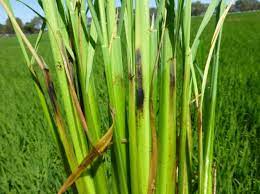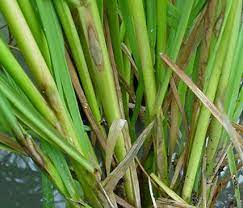Rice stems refer to the elongated, slender structures that support the leaves, flowers, and seeds of rice plants (Oryza sativa), which is one of the most important cereal crops and a staple food for a significant portion of the world’s population. The stems of rice plants play a vital role in providing structural support, transporting nutrients and water, and facilitating the overall growth and development of the plant.
Rice stems are hollow and cylindrical, consisting of nodes and internodes. Nodes are the points along the stem where leaves, branches, and reproductive structures (such as flowers and seeds) are attached, while internodes are the segments between nodes. The length and height of rice stems can vary depending on the rice variety, growing conditions, and agricultural practices. Generally, rice stems can range from a few inches to several feet in length.
The primary function of rice stems is to provide structural support to the entire plant. They help keep the plant upright, allowing leaves to access sunlight and facilitating efficient photosynthesis. Rice stems serve as conduits for the transportation of water, nutrients, and minerals from the roots to other parts of the plant. They also play a role in transporting sugars produced during photosynthesis from the leaves to other parts of the plant.
As rice plants grow, new stem segments are produced at the nodes. These segments elongate and push the growing tips of the plant upward, leading to overall plant growth and development.
Rice stems are a critical component of the rice plant’s anatomy, providing the necessary support, transportation, and reproductive structures that contribute to its growth and eventual production of rice grains.
The Economic Importance and Uses of Rice Stems

Rice stems, while often overlooked, have several economic importance and uses. They are not only agricultural waste but can also be utilized in various ways to benefit different industries and applications.
Here are some of the economic importance and uses of rice stems:
1. Biofuel Production: Rice stems can be used as a potential feedstock for biofuel production. Cellulosic materials in rice stems can be converted into biofuels such as ethanol through processes like fermentation and enzymatic conversion. This helps reduce the reliance on fossil fuels and contributes to a more sustainable energy mix.
2. Animal Feed: Rice stems can be used as fodder for livestock. They can be chopped, dried, and mixed into animal feed to provide dietary fiber and nutrition. While the stems may not be as nutritious as grains, they can still contribute to a balanced diet for animals.
3. Mulching: Rice stems can be used as a natural mulch in agriculture. They help retain soil moisture, suppress weed growth, and improve soil structure. Farmers can lay rice stems on the soil surface around plants to create a protective layer.
4. Composting: Rice stems can be added to compost piles to enhance the decomposition process and improve the quality of the resulting compost. The cellulose-rich stems contribute to the carbon content of the compost, which is essential for creating a balanced carbon-to-nitrogen ratio.
Read Also: Rice Roots: Economic Importance, Uses and By-Products
5. Craft and Artistic Purposes: Rice stems can be used in crafts and artistic projects. They can be woven into baskets, mats, and decorative items, adding a touch of natural aesthetic to various products.
6. Paper and Pulp Industry: The cellulose content of rice stems makes them suitable for paper and pulp production. By processing rice stems, the fibers can be extracted and used as raw material for making paper products.
7. Bio-based Materials: Rice stems can be used to produce bio-based materials like bioplastics and bio-based composites. These materials have applications in various industries, including packaging, construction, and automotive, as sustainable alternatives to traditional plastics and materials.
8. Mushroom Cultivation: Rice stems can be used as a substrate for growing certain types of edible and medicinal mushrooms. The stems provide a nutrient-rich medium for mushroom mycelium to colonize and produce fruiting bodies.
9. Soil Erosion Control: In areas prone to soil erosion, rice stems can be used to create natural barriers and stabilize soil. They can be woven into mats or placed strategically on slopes to prevent soil erosion.
10. Bioremediation: Rice stems can be utilized in bioremediation efforts to clean up contaminated environments. Certain types of plants, including rice, have the ability to absorb and accumulate heavy metals from the soil, which can help in soil remediation.
11. Construction Material: Rice stems can be processed and used as a building material. When combined with other materials, such as clay or cement, they can create eco-friendly and cost-effective construction components like bricks, panels, and thatch for roofing.
12. Textile and Fiber Production: The cellulose fibers from rice stems can be extracted and processed to create natural textile fibers. These fibers can be spun into yarn and used to make fabrics, ropes, and other textile products.
13. Horticultural Uses: In horticulture, rice stems can be used to support climbing plants. They can be fashioned into trellises or stakes to provide structural support to vines, creepers, and other plants that need to grow vertically.
14. Renewable Energy Generation: Rice stems can be used in biomass power generation. When burned or converted into biogas through anaerobic digestion, they can provide a source of renewable energy to power homes, industries, and even generate electricity in rural areas.
15. Erosion Control and Riparian Buffer Zones: Along riverbanks and other water bodies, rice stems can be planted as part of riparian buffer zones. Their root systems help stabilize the soil, prevent erosion, and filter runoff, contributing to improved water quality.
16. Traditional Practices: In some cultures, rice stems have traditional uses. For example, in certain regions, rice stems are woven into hats, mats, and baskets for household and cultural purposes.
17. Research and Innovation: Researchers and scientists can use rice stems for various studies and experiments. They can analyze the composition of the stems, study their mechanical properties, and explore potential applications in emerging fields like biotechnology and nanotechnology.
18. Carbon Sequestration: Plant residues, including rice stems, can play a role in carbon sequestration by locking carbon dioxide from the atmosphere into the soil. This contributes to mitigating climate change and improving soil fertility.
19. Aesthetic and Decorative Purposes: Rice stems can be used in floral arrangements and decorations. Dried rice stems can add a unique texture and visual appeal to bouquets and centerpieces.
20. Educational and Awareness Initiatives: Rice stems can be utilized in educational programs to raise awareness about sustainable agriculture, waste reduction, and environmental conservation. They can serve as tangible examples in workshops and demonstrations.
The Products and By-products That Can Be Derived From Rice Stems

Rice stems are a by-product of rice cultivation, and while they might not be as well-known as rice grains, they can still be put to various uses.
Here are some potential products and by-products that can be derived from rice stems, along with explanations, examples, and processes:
1. Animal Bedding: Rice stems can be used as bedding material for livestock, such as cattle, poultry, and horses. It provides insulation, comfort, and helps in waste management.
2. Mulch: Chopped rice stems can serve as mulch for gardens and agricultural fields. It helps retain soil moisture, suppress weed growth, and improve soil structure.
3. Compost: Rice stems can be added to compost piles to create nutrient-rich compost for soil enrichment.
4. Biofuel: Rice stems can be converted into biofuels such as biogas, bioethanol, and bio-oil through processes like anaerobic digestion and thermochemical conversion.
5. Heat Generation: Rice stems can be burned to generate heat for cooking or as a source of renewable energy.
6. Handicrafts: Rice stems can be used for making various handicrafts, such as baskets, hats, and mats.
Read Also: PawPaw/Papaya Latex: Economic Importance, Uses and By-Products
7. Paper and Cardboard: Rice stems fibers can be processed to make paper and cardboard products.
8. Growing Medium: Rice stems can be used as a substrate for cultivating edible and medicinal mushrooms, such as oyster mushrooms.
9. Erosion Control Mats: Rice stems can be woven into mats that are used for erosion control on slopes and embankments.
10. Livestock Feed: Although not as nutritionally rich as rice grains, rice stems can be processed and used as a supplementary feed source for livestock after proper treatment.
11. Packaging Material: Processed rice stems can be used as a biodegradable alternative to plastic packaging materials.
12. Building Material: Rice stems can be used as a component in making panels, boards, and bricks for construction purposes.
13. Biochar: Rice stems can be converted into biochar, a type of charcoal used as a soil amendment to improve soil fertility and water retention.
It is important to note that while rice stems offer potential value as by-products, their use may be limited by factors such as regional availability, processing costs, and technological constraints. As technologies and research continue to advance, new and innovative uses for rice stems and other agricultural by-products may emerge.
In conclusion, the economic importance and uses of rice stems are diverse and encompass a wide range of industries and applications. As societies continue to seek sustainable solutions and utilize agricultural byproducts, rice stems offer valuable opportunities for resource optimization, waste reduction, and the creation of innovative products and practices.
Read Also: What is some advantages of solar energy?
